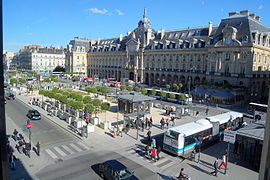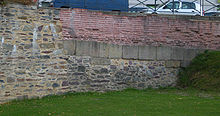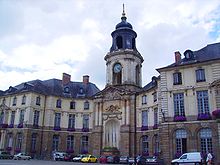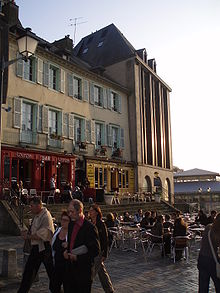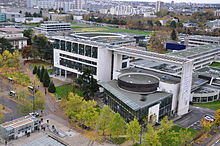- Rennes
-
Rennes
Motto: Vivre en intelligence (French: "Live intelligently")
The Republic Square with the Commerce Palace from 1922 

City flag City coat of arms Administration Country France Region Brittany Department Ille-et-Vilaine Arrondissement Rennes Canton Chief town of 11 cantons Intercommunality Rennes Métropole Mayor Daniel Delaveau (PS)
(2008–2014)Statistics Elevation 20–74 m (66–243 ft)
(avg. 30 m/98 ft)Land area1 50.39 km2 (19.46 sq mi) Population2 206,655 (2008) - Density 4,101 /km2 (10,620 /sq mi) INSEE/Postal code 35238/ 35000, 35200, 35700 Website http://www.rennes.fr/ 1 French Land Register data, which excludes lakes, ponds, glaciers > 1 km² (0.386 sq mi or 247 acres) and river estuaries. 2 Population without double counting: residents of multiple communes (e.g., students and military personnel) only counted once. Coordinates: 48°06′53″N 1°40′46″W / 48.114722°N 1.679444°W
Rennes ([ʁɛn] (
 listen) French: Rennes, Gallo: Resnn, Breton: Roazhon, Latin: Condate, Civitas Redonum) is a city in the east of Brittany in northwestern France. Rennes is the capital of the region of Brittany, as well as the Ille-et-Vilaine department.
listen) French: Rennes, Gallo: Resnn, Breton: Roazhon, Latin: Condate, Civitas Redonum) is a city in the east of Brittany in northwestern France. Rennes is the capital of the region of Brittany, as well as the Ille-et-Vilaine department.Contents
History
Rennes is the administrative capital of the country of Brittany, in France, the other historical capital being Nantes. It has a long history due to its location at the confluence of two rivers.
The eastern Armorican people of Redones founded Condate —an ancient Celtic word meaning confluent— at the confluence of the Ille and Vilaine rivers and made it the capital of a territory that extended to the Bay of Mont Saint-Michel. The name of the city of Redon also reflects that of the Redones. Early in the 1st century BCE, they adopted the Greek and Roman practice of issuing coinage,[1] adapting the widely imitated gold staters of Philip II of Macedon, in the characteristic Celtic coin metal alloy called billion. Without inscriptions, as the Celtic practice was, the Redones coinage features a charioteer whose pony has a human head. Large hoards of their coins were unearthed in the "treasure of Amanlis" found in June 1835 and that of Saint-Jacques-de-la-Lande, discovered in February 1941. The Museum at Rennes contains a large representative collection.
They joined the Gaulish coalition against Rome in 57 BC, which was suppressed by Crassus. The following year, Roman emissaries were held hostage by the Redones, which obliged Julius Caesar to intervene in Armorica and suppress the rebels, and the following year to cross the Channel to discourage further support of the Redones by the Britons. In 52 the Redones responded to the call of Vercingetorix to furnish a large contingent of warriors[2]
Roman era
In the Roman era, Condate became Condate Riedonum, capital of Civitas Riedonum.
The oldest known rennais is Titus Flavius Postuminus, known to us from his steles found in Rennes in 1969. As indicated by his name, he would have been born under the Flavian dynasty, under the reign of Titus, i.e. between 79 and 81 AD. One of the steles tell us, in Latin, that he took charge over all the public affairs in the Civitas Riedonum. He was twice duumvir and flamen for life for Mars Mullo.
During the Roman era, the strategic position of the town contributed to its importance. To the west the principal Roman route, via Osismii stretched from Condate to Vorgium (modern Carhaix).
In the year 275, the threat of barbarians led to the erection of a robust brick wall around Rennes. Rennes became known as the "red town".
Threatened by the danger of peasant marauders called bagaudae at the end of the Roman Empire in the 5th century, the Armorican peninsula, including Brittany and therefore Rennes, constituted the last of the strongholds of the western Roman Empire. The invincible Armorican Romans held their ground against Clovis I, who occupied most of Alamans, then the Visigoths. Melaine, the bishop of Rennes, played an important role in the peace treaty between the Franks and the Armoricans in the year 497. He famously declared "Il faut faire la paix entre chrétiens" ("Peace must be made between Christians").
Middle Ages
Starting in the 5th century, Bretons occupied the western part of the Armorican peninsula, which started to be called Little Britain, and then Brittany, while the Franks took the rest of Armorica. To contain the expansion and avoid Breton incursions, the Carolingians instituted a Breton march or frontier province, composed of the counties of Rennes, Nantes, and Vannes.
These marches were entirely absorbed by the Breton Kingdom in the 9th century, and Rennes became Breton in 851. Rennes would later become the capital of the duchy of Brittany.
During the Breton War of Succession, in 1356 and 1357, the city was laid siege to by Henry of Grosmont, the Duke of Lancaster, cousin of the English king, but Bertrand du Guesclin slipped into the city and took over the resistance, which would ultimately be victorious. After nearly a year, Lancaster abandoned the English siege in 1357.
In 1491, the French army of Charles VIII, led by General Louis II de la Trémoille, unsuccessfully attacked Rennes. Brittany having already capitulated elsewhere, Rennes alone still resisted. The defenders of Rennes were determined to resist to the death, but the Duchess Anne of Brittany chose instead to negotiate. By her marriage to Charles VIII, she made Brittany a part of France. Anne jealously guarded Brittany's autonomy, but the duchy was eventually fully merged with the French crown by her daughter Claude of France.
Modern era
In 1857 the Rennes train station was built, which gradually led to the southward sprawl of the town. In 1899 Alfred Dreyfus' trial in Rennes caused a national commotion.
During World War II Rennes suffered heavy damage from just three German aircraft which hit an ammunition train parked alongside French and English troop trains and near a refugee train on the yard: 1,000 died. The next day, 18 June 1940, German troops entered the city. Later, Rennes endured heavy bombings by the US and Royal Air Forces in March and May 1943, and again in June 1944, causing hundreds of deaths. Rennes contained a German transit POW camp and a POW hospital which contained many of the paratroopers captured on D-Day. Patton's army freed the capital of Brittany on 4 August, as retreating German troops blew up the bridges behind them, adding further damage. About 50,000 German prisoners were kept in four camps, in a city of only about 100,000 inhabitants at the time.
From 1954 onwards the city developed extensive building plans to accommodate upwards of 220,000 inhabitants,[3] helping it become the third fastest-growing city in France, after Toulouse and Montpellier (1999 census).
Administration
Rennes is divided into 11 cantons:
- Canton of Rennes-Brequigny (15,397 inhabitants)
- Canton of Rennes-Centre (19,017 inhabitants)
- Canton of Rennes-Centre-Ouest (21,264 inhabitants)
- Canton of Rennes-Centre-Sud (15,774 inhabitants)
- Canton of Rennes-Est (20,323 inhabitants)
- Canton of Rennes-le-Blosne (21,151 inhabitants)
- Canton of Rennes-Nord (21,845 inhabitants)
- Canton of Rennes-Nord-Est (18,224 inhabitants)
- Canton of Rennes-Nord-Ouest, which includes parts of Rennes but also the communes of Gévezé, Pacé and Parthenay-de-Bretagne (28,130 inhabitants)
- Canton of Rennes-Sud-Est, which includes parts of Rennes and the communes of Chantepie and Vern-sur-Seiche (33,459 inhabitants)
- Canton of Rennes-Sud-Ouest, which includes parts of Rennes and the communes of Saint-Jacques-de-la-Lande and Vezin-le-Coquet (28,707 inhabitants)
Since the 2008 cantonal elections, all eleven cantons are held by Socialists or their allies. The right held Rennes-Nord-Ouest until 2008.
Rennes is divided into 12 quarters:
- Le Centre
- Thabor/Saint Hélier
- Bourg l'Évêque-Moulin du Comte
- Saint-Martin
- Maurepas-Patton-Bellangerais
- Jeanne d’Arc-Longs-Champs-Beaulieu
- Francisco Ferrer-Landry-Poterie
- Sud Gare
- Cleunay-Arsenal-Redon
- Villejean-Beauregard
- Le Blosne
- Bréquigny
Mayors
The current mayor of Rennes is Daniel Delaveau, a member of the Socialist Party who replaced retiring Socialist incumbent Edmond Hervé, in office from 1977 to 2008.
- Henri Fréville (1905–1987), mayor MRP from 1953 to 1977.
- Eugène Quessot (1882–1949), interim mayor from 15 July 1947 until 26 October 1947
- Yves Milon (1897–1987), mayor RPF from 1944 to 1953.
Among previous well-know mayors is:
- Jean Janvier (1859–1923), from 1908 to 1923
- Edgar Le Bastard (1836–1891), from 1880 to 1891
- Toussaint-François Rallier du Baty (1665–1734) from 1695 to 1734
The mairie (City hall) is right in the centre of Rennes.
National representation
The French Prison Service operates the Centre pénitentiaire de Rennes, the largest women's prison in France.[4]
Geography
The ancient centre of the town is built on a hill, with the north side being more elevated than the south side. It is at the confluence of two rivers: the Ille and the Vilaine.
Climate
Climate data for Rennes, Brittany Month Jan Feb Mar Apr May Jun Jul Aug Sep Oct Nov Dec Year Average high °C (°F) 8.1
(46.6)9.4
(48.9)12.3
(54.1)14.7
(58.5)18.4
(65.1)21.5
(70.7)23.8
(74.8)23.6
(74.5)21.1
(70.0)16.7
(62.1)11.7
(53.1)9
(48)15.86
(60.54)Average low °C (°F) 2.2
(36.0)2.5
(36.5)4
(39)5.4
(41.7)8.5
(47.3)11.2
(52.2)13.1
(55.6)13.1
(55.6)11.2
(52.2)8.3
(46.9)4.9
(40.8)3.2
(37.8)7.30
(45.14)Precipitation mm (inches) 61.3
(2.413)52.3
(2.059)49.3
(1.941)45.1
(1.776)58.1
(2.287)46.4
(1.827)42.6
(1.677)47.3
(1.862)56.6
(2.228)63.8
(2.512)68.4
(2.693)69.1
(2.72)660.3
(25.996)Source: Météo France Demographics
Historical populations Year Pop. ±% 1793 30,160 — 1800 25,904 −14.1% 1806 29,225 +12.8% 1821 29,589 +1.2% 1831 27,340 −7.6% 1836 35,552 +30.0% 1841 37,895 +6.6% 1846 39,218 +3.5% 1851 39,505 +0.7% 1856 45,664 +15.6% 1861 45,483 −0.4% 1866 48,283 +6.2% 1872 52,044 +7.8% 1876 57,177 +9.9% 1881 60,974 +6.6% 1886 66,139 +8.5% 1891 69,232 +4.7% 1896 69,937 +1.0% 1901 74,676 +6.8% 1906 75,640 +1.3% 1911 79,372 +4.9% 1921 82,241 +3.6% 1926 83,418 +1.4% 1931 88,659 +6.3% 1936 98,538 +11.1% 1946 113,781 +15.5% 1954 124,122 +9.1% 1962 151,948 +22.4% 1968 180,943 +19.1% 1975 198,305 +9.6% 1982 194,656 −1.8% 1990 197,536 +1.5% 1999 206,229 +4.4% 2005 210,500 +2.1% 2008 211,778 +0.6% Starting in 1962: Population with duplicates – Sources : Cassini[5] and INSEE[6] The population of the city (commune) of Rennes at the 1999 census was 206,229 inhabitants (209,100 inhabitants as of February 2004 estimates). The inhabitants of Rennes are called Rennais. Rennes has the 3rd fastest growing Metropolitan area in France. The population of the metropolitan area at the 1999 census was 521,188 inhabitants, and 588,684 inhabitants as of the 2007 estimate.
Main sights
Rennes is classified as a city of art and history.
Historic Centre
The Parlement de Bretagne (Administrative and judicial centre of Brittany, Breton: Breujoù Breizh) is arguably the most famous 17th century building in Rennes. It was rebuilt after a terrible fire in 1994 caused by a flare fired by a protester during a demonstration. It houses the Rennes Court of Appeal.
Basilica Saint-Sauveur is also located in the historic centre.
Colourful traditional half-timbered houses are situated primarily along the roads of Saint-Sauveur, Saint-Georges, de Saint-Malo, Saint-Guillaume, des Dames, du Chapitre, Vasselot, Saint-Michel, de la Psallette and around the plazas of Champ-Jacquet, des Lices, Saint-Anne and Rallier-du-Baty.
There are 16th century polychromatic wooden busts in the façade of 20, Rue du Chapitre.
- Place des Lices and surrounding area
- Les Halles Martenot of the 19th century, built between 1868 and 1871 by Jean-Baptiste Martenot, host the market on Saturday mornings (the third largest market in France).
- The Mordelaises Gate (Portes Mordelaises), chatelet with two towers and a drawbridge
- The remaining fortifications from the 3rd century
- The Jehan Duchesne tower of the 15th century, on rue Nantaise
- The 15th century ramparts east of the Gallo-Roman fortifications, in Rallier-du-Baty square.
- Rennes Cathedral (cathédrale Saint-Pierre de Rennes)
- The former St. Yves chapel, now the tourism office and a museum about historical Rennes development.
- Place Saint-Anne (Plasenn Santez-Anna)
- La rue Saint-Michel nicknamed Rue de La Soif (Road of Thirst) because there are bars all along this street.
- Area from Saint-Melaine to Saint-Melaine square
- Notre-Dame-en-Saint-Melaine basilica,
- Magnificent park, The Parc Thabor, (formal French garden, orangerie, rose garden, aviary), on 10 hectares of land, built between 1860 and 1867. Contains the Jardin botanique du Thabor, a botanical garden.
- The 17th century promenade "la Motte à Madame", and a monumental stairway overlooking the rue de Paris entrance to the Thabor.
- Rue Saint-Georges and rue Gambetta
- 1920s Saint George Municipal Pool, with mosaics
- Saint George Palace, and its garden
- Place de la Mairie (City Hall Plaza, Plasenn Ti Kêr)
- City Hall
- Opera
- Vau-Saint-Germain square
- Saint-Germain Church
- Saint-Germain footbridge, 20th century wood and metal construction to link the plaza with Émile Zola Quay, across the Vilaine River.
- Champ-Jacquet square
- statue of Leperdit ripping up a conscription list.
- Rue du Chapitre
- Hôtel de Blossac
South of the Vilaine
The Fine Arts Museum is situated on Quai Émile Zola (Émile Zola Quay), by the Vilaine River.
Les Champs Libres is a building on Esplanade Charles de Gaulle designed by the architect Christian de Portzamparc that houses the Brittany Museum (Musée de Bretagne), regional library Bibliothèque de Rennes Métropole on six levels and a Espace des Sciences science centre with a planetarium.
At Place Honoré Commeurec is Les Halles Centrales, a covered market of 1922, with a part converted into contemporary art gallery.
Mercure Hotel is located in a restored building on rue du Pré-Botté, which was the prior location of Ouest-Éclair, and then of Ouest-France, a premier daily regional newspaper.
There are large mills at Rue Duhamel, constructed on each side of the south branch of the Vilaine in 1895 and 1902.
Other sights
To the North-west of Rennes, near rue de Saint-Malo are the locks of the Canal d'Ille-et-Rance of 1843.
There are two halls of the printer, Oberthür, built by Marthenot between 1870 and 1895 on Rue de Paris in the eastern part of the city. Oberthür Park is the second biggest garden in the city.
The 17th century manor of Haute-Chalais, a granite chateau, is situated to the south of the city in Blosne Quarter (Bréquigny).
Economy
Local industries include car manufacturing and telecommunications. PSA Peugeot Citroën, currently the largest employer of the population of Rennes, opened a manufacturing plant at Rennes La Janais in 1961. Technicolor (ex-Thomson) employs over 1,000, and France Telecom R&D over 1,200.
In few years, Rennes became one of the main centres in high tech industry.[citation needed] Rennes is one of first Technopoles in France that were established in an effort to stimulate the economies of regions other than Paris during the Aménagement du territoire.
Rennes is the 2nd concentration of ITC firms in France after Paris(with well-known companies like Atos, SFR, Orange France Telecom, Technicolor R&D, Canon, Mitsubishi, Alcatel-Lucent, Texas Instruments, NXP, Thales or Logica), and the 3rd innovation potential in agrofood French industry.
Culture
Rennes invests heavily in arts and culture and a number of its festivals (such as the music festival Les Transmusicales, les Tombées de la Nuit and Travelling (a cinematic festival)) are well known throughout France. Rennes was one of the first towns in France to have its own television channel 'TV Rennes', created in 1987. In Rennes is the only Institut Franco-Américain in France. There are 4 museums in Rennes:
- Musée des Beaux Arts (Museum of Fine Arts of Rennes).
- Musée de Bretagne (Museum of Brittany) at the Champs Libres, together with le 'espace of sciences' and a planetarium.
- Museum of Farming and Rennes Countryside at la Bintinais, south of Rennes.
- Musée des Transmissions (Museum of Broadcasting) at Cesson-Sévigné, west of Rennes center.
The Parc du Thabor contains a compact but significant botanical garden, the Jardin botanique du Thabor. The University of Rennes 1, with a campus in the city's eastern section, also contains a botanical garden and collections (the Jardin botanique de l'Université de Rennes).
Education
The Rennes agglomeration has a large student population (around 60,000). The Breton language is taught in one Diwan school, some bilingual public and catholic schools, in evening courses, and in university.[7]
The city has two main universities; Université de Rennes 1, which offers courses in science, technology, medicine, philosophy, law, management and economics and Université Rennes 2, which has courses in the arts, literature, languages, communication, human and social sciences, sport.
There are a few École Supérieures in Rennes. The École Normale Supérieure de Cachan has a branch on the Ker Lann campus, just outside Rennes. An École Supérieure for political science, Institut d'études politiques de Rennes (site), is also based in Rennes.
There is also a branch of École Supérieure d'Électricité – Supélec in the east of the city (Cesson-Sévigné), Ecole Supérieure de Commerce de Rennes and the grande école Institut National des Sciences Appliquées, which is next to the "École Nationale Supérieure de Chimie de Rennes".
The computer science and applied mathematics research institute, IRISA, is located on the campus of the Université des Sciences, nearby Cesson-Sévigné. The Délégation Générale pour l'Armement (defense procurement agency) operates the CELAR research center, dedicated to electronics and computing, in Bruz, a neighboring town.
Breton language
The municipality launched a linguistic plan through Ya d'ar brezhoneg on 24 January 2008.
In 2008, 2.87% of the children were enrolled in bilingual primary schools and the number of children enrolled in these schools is steadily growing.[8]
Sport
Football club
Rennes is home to Stade Rennais F.C., who play at Route de Lorient stadium (capacity of 31,000 seats) in the French Division One.
Transport
Rennes has well-developed national road, rail and air links. Local transport is based primarily on an extensive bus network (38 different lines) and a metro line that was inaugurated in March 2002 and cost €500 million to build. The driverless Rennes Metro (VAL) is 9.4 km (5.8 mi) in length and has 15 stations, including one designed by architect Norman Foster (La Poterie station).
A second metro line is being planned, it should be operational by 2018, and the construction will begin in 2013.[9]
The Gare de Rennes, opened in 1857, is now two hour and twenty minutes by TGV high speed train from Paris. This will be reduced to one hour and 30 minutes from 2014, after extension of the High Speed Rail Line.[10] Rennes is also an important train station for regional transport in Bretagne.
Rennes is also served by a small airport, Rennes-St. Jacques Airport, located 7.2 kilometres (4.5 mi) from the centre to the south-west in the commune Saint-Jacques-de-la-Lande.
Notable people
- Bertrand d'Argentré (1519–1590) jurist and historian, seneschal of Rennes in 1547 than head of the présidial court.
- Pierre Robiquet, 1780–1840, chemist, member of Académie des Sciences, discover of among others codein, asparagin and alizarin
- Georges Ernest Boulanger (1837–1891) general and politician born in Rennes.
- René Pleven (1901–1993), two times Presidents of the Council of Ministers, born in Rennes.
- Jacques Legrand (1946–), Mongologist
- Edwige Lawson (1974–) basketball player
- Francois-Henri Pinault (1962–) Chairman and CEO of PPR.
- Laure Sinclair Adult film actress
- Malika Ménard Miss France 2010
International relations
Twin towns – sister cities
Rennes is twinned with:
(These twinned towns are inscribed on the bridge over the central canal of Rennes)
Within France
 Saint-Gilles-du-Mené, France (since 1978)
Saint-Gilles-du-Mené, France (since 1978) Rennes-les-Bains, France (since 1985)
Rennes-les-Bains, France (since 1985)
Pacts of cooperation
 Hué, Vietnam (since 1992)
Hué, Vietnam (since 1992) Bandiagara Cercle, Mali (since 1995)
Bandiagara Cercle, Mali (since 1995)
Sponsorship
 Vouziers, France
Vouziers, France
Broadcasting facilities
- Transmitter Rennes-Thourie
Image gallery
-
The Ouest-France building
References
- ^ "VSO 15 – Armorica, Redones coinage (Rennes) – Mail Bid Sale". Cgb.fr. 1 March 2002. http://www.cgb.fr/monnaies/vso/v15/gb/sommairegb63d2.html?sommaire=Armorica%2C%20Redones%20coinage%20(Rennes)&nbfic=1515. Retrieved 22 July 2009.
- ^ Caesar, Gallic Wars II.34; VII.75
- ^ "Insee – Populations légales 2008 – 35238-Rennes". Insee.fr. http://www.insee.fr/fr/ppp/bases-de-donnees/recensement/populations-legales/commune.asp?depcom=35238. Retrieved 6 April 2011.
- ^ "French pedophilia trial casts unsettling light on women sex offenders." Agence France Presse at The Island. 14 March 2005. Retrieved on 19 March 2011.
- ^ "Population avant le recensement de 1962". Cassini.ehess.fr. http://cassini.ehess.fr/cassini/fr/html/6_index.htm. Retrieved 6 April 2011.
- ^ "INSEE : Population depuis le recensement de 1962". Insee.fr. http://www.insee.fr/fr/ffc/docs_ffc/psdc.htm. Retrieved 6 April 2011.
- ^ (French) L'état de la langue bretonne dans l'enseignement en Ille-et-Villaine (State of the Breton language in education in Ille-et-Villaine) from Ofis ar Brezhoneg
- ^ (French) Ofis ar Brezhoneg: Enseignement bilingue
- ^ (French) Rennes.maville.com Le projet de nouvelle ligne du métro sur les rails
- ^ "Rennes à 1h30 de Paris en 2014 – France – Toute l'actualité en France". France Info. http://www.france-info.com/france-regions-2008-07-29-rennes-a-1h30-de-paris-en-2014-166590-9-13.html. Retrieved 6 April 2011.
- ^ "Brno – Partnerská města" (in Czech). 2006–2009 City of Brno. http://www.brno.cz/index.php?nav02=1985&nav01=34&nav03=1010&nav04=1016&nav05=1249&nav06=1272. Retrieved 17 July 2009.
- ^ "Poznań Official Website – Twin Towns".
 (in Polish) 1998–2008 Urząd Miasta Poznania. http://www.poznan.pl/mim/public/publikacje/pages.html?co=list&id=19&ch=20&instance=1017&lang=pl. Retrieved 29 November 2008.
(in Polish) 1998–2008 Urząd Miasta Poznania. http://www.poznan.pl/mim/public/publikacje/pages.html?co=list&id=19&ch=20&instance=1017&lang=pl. Retrieved 29 November 2008.
External links
Prefectures of the regions of France Metropolitan France Strasbourg (Alsace) · Bordeaux (Aquitaine) · Clermont-Ferrand (Auvergne) · Dijon (Burgundy) · Rennes (Brittany) · Orléans (Centre) · Châlons-en-Champagne (Champagne-Ardenne) · Ajaccio (Corsica) · Besançon (Franche-Comté) · Paris (Île-de-France) · Montpellier (Languedoc-Roussillon) · Limoges (Limousin) · Metz (Lorraine) · Toulouse (Midi-Pyrénées) · Lille (Nord-Pas de Calais) · Caen (Lower Normandy) · Rouen (Upper Normandy) · Nantes (Pays de la Loire) · Amiens (Picardy) · Poitiers (Poitou-Charentes) · Marseille (Provence-Alpes-Côte d'Azur) · Lyon (Rhône-Alpes)
Overseas regions Cayenne (French Guiana) · Basse-Terre (Guadeloupe) · Fort-de-France (Martinique) · Mamoudzou (Mayotte) · Saint-Denis (Réunion)
Communes of the Ille-et-Vilaine department 
Acigné · Amanlis · Andouillé-Neuville · Antrain · Arbrissel · Argentré-du-Plessis · Aubigné · Availles-sur-Seiche · Baguer-Morvan · Baguer-Pican · Baillé · Bain-de-Bretagne · Bains-sur-Oust · Bais · Balazé · Baulon · La Baussaine · La Bazouge-du-Désert · Bazouges-la-Pérouse · Beaucé · Bécherel · Bédée · Betton · Billé · Bléruais · Boisgervilly · Boistrudan · Bonnemain · La Bosse-de-Bretagne · La Bouëxière · Bourg-des-Comptes · Bourgbarré · La Boussac · Bovel · Bréal-sous-Montfort · Bréal-sous-Vitré · Brécé · Breteil · Brie · Brielles · Broualan · Bruc-sur-Aff · Les Brulais · Bruz · Campel · Cancale · Cardroc · Cesson-Sévigné · Champeaux · Chancé · Chanteloup · Chantepie · La Chapelle-aux-Filtzméens · La Chapelle-Bouëxic · La Chapelle-Chaussée · La Chapelle-de-Brain · La Chapelle-des-Fougeretz · La Chapelle-du-Lou · La Chapelle-Erbrée · La Chapelle-Janson · La Chapelle-Saint-Aubert · La Chapelle-Thouarault · Chartres-de-Bretagne · Chasné-sur-Illet · Châteaubourg · Châteaugiron · Châteauneuf-d'Ille-et-Vilaine · Le Châtellier · Châtillon-en-Vendelais · Chauvigné · Chavagne · Chelun · Cherrueix · Chevaigné · Cintré · Clayes · Coësmes · Coglès · Comblessac · Combourg · Combourtillé · Cornillé · Corps-Nuds · La Couyère · Crevin · Le Crouais · Cuguen · Dinard · Dingé · Dol-de-Bretagne · Domagné · Domalain · La Dominelais · Domloup · Dompierre-du-Chemin · Dourdain · Drouges · Eancé · Epiniac · Erbrée · Ercé-en-Lamée · Ercé-près-Liffré · Essé · Étrelles · Feins · Le Ferré · Fleurigné · La Fontenelle · Forges-la-Forêt · Fougères · La Fresnais · Gaël · Gahard · Gennes-sur-Seiche · Gévezé · Gosné · La Gouesnière · Goven · Grand-Fougeray · La Guerche-de-Bretagne · Guichen · Guignen · Guipel · Guipry · Hédé-Bazouges · L'Hermitage · Hirel · Iffendic · Les Iffs · Irodouër · Janzé · Javené · Laignelet · Laillé · Lalleu · Landavran · Landéan · Landujan · Langan · Langon · Langouet · Lanhélin · Lanrigan · Lassy · Lécousse · Lieuron · Liffré · Lillemer · Livré-sur-Changeon · Lohéac · Longaulnay · Le Loroux · Le Lou-du-Lac · Lourmais · Loutehel · Louvigné-de-Bais · Louvigné-du-Désert · Luitré · Marcillé-Raoul · Marcillé-Robert · Marpiré · Martigné-Ferchaud · Maure-de-Bretagne · Maxent · Mecé · Médréac · Meillac · Melesse · Mellé · Mernel · Messac · La Mézière · Mézières-sur-Couesnon · Miniac-Morvan · Miniac-sous-Bécherel · Le Minihic-sur-Rance · Mondevert · Montauban-de-Bretagne · Montautour · Mont-Dol · Monterfil · Montfort-sur-Meu · Montgermont · Monthault · Montours · Montreuil-des-Landes · Montreuil-le-Gast · Montreuil-sous-Pérouse · Montreuil-sur-Ille · Mordelles · Mouazé · Moulins · Moussé · Moutiers · Muel · La Noë-Blanche · La Nouaye · Nouvoitou · Noyal-Châtillon-sur-Seiche · Noyal-sous-Bazouges · Noyal-sur-Vilaine · Orgères · Ossé · Pacé · Paimpont · Pancé · Parcé · Parigné · Parthenay-de-Bretagne · Le Pertre · Le Petit-Fougeray · Pipriac · Piré-sur-Seiche · Pléchâtel · Pleine-Fougères · Plélan-le-Grand · Plerguer · Plesder · Pleugueneuc · Pleumeleuc · Pleurtuit · Pocé-les-Bois · Poilley · Poligné · Pont-Péan · Princé · Québriac · Quédillac · Rannée · Redon · Renac · Rennes · Retiers · Le Rheu · La Richardais · Rimou · Romagné · Romazy · Romillé · Roz-Landrieux · Roz-sur-Couesnon · Sains · Saint-Armel · Saint-Aubin-d'Aubigné · Saint-Aubin-des-Landes · Saint-Aubin-du-Cormier · Saint-Aubin-du-Pavail · Saint-Benoît-des-Ondes · Saint-Briac-sur-Mer · Saint-Brice-en-Coglès · Saint-Brieuc-des-Iffs · Saint-Broladre · Saint-Christophe-de-Valains · Saint-Christophe-des-Bois · Saint-Coulomb · Saint-Didier · Saint-Domineuc · Sainte-Anne-sur-Vilaine · Sainte-Colombe · Sainte-Marie · Saint-Erblon · Saint-Étienne-en-Coglès · Saint-Ganton · Saint-Georges-de-Chesné · Saint-Georges-de-Gréhaigne · Saint-Georges-de-Reintembault · Saint-Germain-du-Pinel · Saint-Germain-en-Coglès · Saint-Germain-sur-Ille · Saint-Gilles · Saint-Gondran · Saint-Gonlay · Saint-Grégoire · Saint-Guinoux · Saint-Hilaire-des-Landes · Saint-Jacques-de-la-Lande · Saint-Jean-sur-Couesnon · Saint-Jean-sur-Vilaine · Saint-Jouan-des-Guérets · Saint-Just · Saint-Léger-des-Prés · Saint-Lunaire · Saint-Malo · Saint-Malo-de-Phily · Saint-Malon-sur-Mel · Saint-Marcan · Saint-Marc-le-Blanc · Saint-Marc-sur-Couesnon · Saint-Maugan · Saint-Médard-sur-Ille · Saint-Méen-le-Grand · Saint-Méloir-des-Ondes · Saint-M'Hervé · Saint-M'Hervon · Saint-Onen-la-Chapelle · Saint-Ouen-des-Alleux · Saint-Ouen-la-Rouërie · Saint-Péran · Saint-Père · Saint-Pern · Saint-Pierre-de-Plesguen · Saint-Rémy-du-Plain · Saint-Sauveur-des-Landes · Saint-Séglin · Saint-Senoux · Saint-Suliac · Saint-Sulpice-des-Landes · Saint-Sulpice-la-Forêt · Saint-Symphorien · Saint-Thual · Saint-Thurial · Saint-Uniac · Saulnières · Le Sel-de-Bretagne · La Selle-en-Coglès · La Selle-en-Luitré · La Selle-Guerchaise · Sens-de-Bretagne · Servon-sur-Vilaine · Sixt-sur-Aff · Sougéal · Taillis · Talensac · Teillay · Le Theil-de-Bretagne · Thorigné-Fouillard · Thourie · Le Tiercent · Tinténiac · Torcé · Trans-la-Forêt · Treffendel · Tremblay · Trémeheuc · Tresbœuf · Tressé · Trévérien · Trimer · Le Tronchet · Val-d'Izé · Vendel · Vergéal · Le Verger · Vern-sur-Seiche · Vezin-le-Coquet · Vieux-Viel · Vieux-Vy-sur-Couesnon · Vignoc · Villamée · La Ville-ès-Nonais · Visseiche · Vitré · Le Vivier-sur-Mer
Categories:- Rennes
- Communes of Ille-et-Vilaine
Wikimedia Foundation. 2010.

